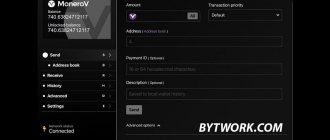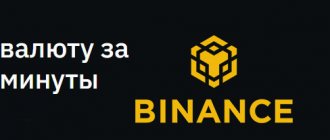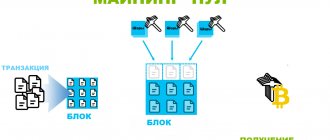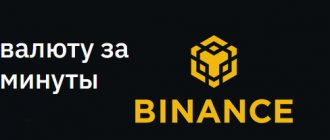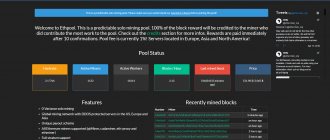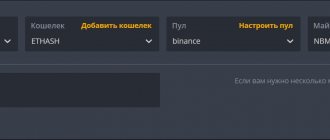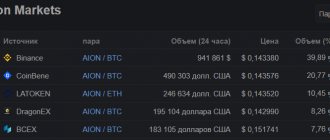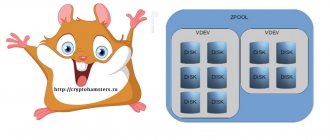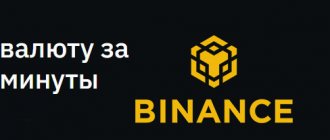Let's look at setting up Ethereum mining. The coin is mined using the Ethash algorithm. This means that mining requires video cards (GPUs).
Here's a quick guide on how to mine Ethereum:
- Select hardware and video cards.
- Install drivers and set up your computer.
- Get an Ethereum wallet address (from an exchange, or install Mist/MyEtherWallet).
- Download the mining program.
- Enter your wallet into the program.
- Disable sleep mode on the system.
- Join the pool.
- Start mining!
Fast start:
To quickly start mining Ether, you need to download the program (miner).
Download any of the following miners for Ether mining.
Our website contains the latest software versions! Therefore, if you have an old version, we strongly advise you to download the latest version of PhoenixMiner using the links below, since with each release of a new version, Ether mining becomes more profitable!
| Program | Series | Setup and download |
| Phoenix Miner | AMD/Nvidia | |
| NBminer | AMD/Nvidia |
Please note that the Claymore Dual Miner program no longer works and with its help you will not be able to mine Ethash coins.
Mining equipment
The following equipment is best suited for Ethereum mining:
Video card: RX 570, RX 580, GTX 1080
Motherboard: ASRock H81 PRO BTC R2.0
Processor:Intel Celeron G1840 (the cheapest one will do)
RAM: Kingston HyperX Fury 4 GB, 1333 MHz, DDR3
Power supply: for GTX 1070 2x Corsair 750 W, for GTX 1080/1080 Ti 2x Seasonic Prime Ultra Platinum 1000 W
SSD: Silicon Power 120GB SSD
Adapter for two power supplies: ADD2PSU
USB risers: VER 008S, 6 pcs.
Frame
Of course, Ether is best mined on “red” video cards (AMD), Nvidia is also possible, but the profit will be much less than if you mine other algorithms tailored for them.
Install drivers
Step 1: Install Video Card Drivers.
The process of assembling a farm takes a long time, especially if you are assembling a farm for the first time. Therefore, the step-by-step diagram for assembling the farm is described in detail here. Read the driver installation process below.
assemble the equipment
Read tips on choosing drivers to determine which drivers are best for mining from AMD and NVIDIA.
AMD
For AMD, you must use the latest version of the “Adrenalin Edition” driver, which you can download from the official AMD website.
https://support.amd.com/en-us/kb-articles/Pages/Radeon-Software-Adrenalin-Edition-18.5.1-Release-Notes.aspx
After downloading and installing, go to the program.
- Next, click on the top tab – “Games”
- A new window opens where you need to click on “Global Settings”
- Next, a new window will open again, where you will immediately configure 1 of your video card.
- Look among all the settings for “GPU workload” - set the mode to “Calculate”
- If you have several video cards - that is, a whole rig, then do the same with other video cards, since 1 action applies only to 1 video card.
- To move to the next video card, click on the top tab (button) “Global graph...”
That's it, now the calculation mode is set, video cards will produce a noticeably higher hashrate!
Nvidia
Download the driver for your video card from the official website. www.nvidia.ru/Download
- In the “product series” field, select your card series. If you have from 1030 to 1080Ti then this is the 10 series. From 2060 to 2080Ti - this is the 20 series. From 1650 to 1660Ti this is the 16 series. If you have from 950 to 980Ti this is the 900 series.
- In “Product Family:” select your video card.
- In “Operating system:” - your OS.
- Click "SEARCH"
After this, a new page will open on which you will be asked to download the latest version of the driver.
After downloading, run and install.
Next, in Windows 10, open “my computer”, right-click on the free space and select “properties”.
In the new window that opens, click on the “Device Manager” button.
Another window will open. Find "Video adapters" and click on it. A list of your video cards will open. If they are not called “Microsoft base adapter”, but rather the name of your Video Card, then you have installed the correct driver.
Farm monitoring and income review
After the farm has been running for a while and sent data to the mining pool, you can view the status and income from the video cards.
For example, for the F2Pool pool, you can go to the official F2Pool website, enter the wallet address in the search bar in the top right corner, select ETC as the currency and click “View” to view the mining status and profitability.
If you have any questions about mining Ethereum Classic or need help, join the telegram chat: https://t.me/bytwork
Create a wallet
Step 2. Get the Ethereum wallet address on the exchange or install the Ethereum wallet on your computer.
In order to mine cryptocurrency, the program (miner) will need to specify the wallet to which the coins will be received.
You can use either official, hardware or partner wallets, or simply get a wallet from the exchange where the coin is traded. For example on Binance.
get a wallet on binance
How to register and open a deposit address is written in the corresponding manual. Having received the wallet address, proceed to the next step.
Download programs
Step 3. Select and download the program.
Now you need to download the mining program. The following are suitable:
| Program | Series | Setup and download |
| Phoenix Miner | AMD/Nvidia | |
| (Out of date soon) Claymore's Dual Ethereum AMD+NVIDIA GPU Miner | AMD/Nvidia |
Each program has an extensive description of all possible settings. If you do not want to set up batch files yourself, you can download the program itself, which will offer already fully configured and ready-made Bat files for different pools; all you have to do is change the wallet to your own. Don't forget to do this.
Prepare your mining rig
System requirements:
- Video cards (NVIDIA and AMD, video memory of at least 3 GB).
- Operating system: Windows, Linux.
- Virtual memory (swap file): Set 5 GB of virtual memory for one video card (for 6 video cards, set to 30 GB).
- Mining software: Phoeinx Miner, T-Rex, Gminer, lolMiner and others.
Select pools
Step 4. Select a mining pool.
The reality is that gone are the days when Bitcoin and Ethereum were easily mined alone on a processor or video card. The complexity has reached such levels that it is necessary to combine your efforts to mine cryptocurrency on a pool.
What is a pool?
In the context of cryptocurrency mining, mining is the pooling of resources of people who share their computing power across a network to share rewards equally based on the amount of work they contributed in proportion to the probability of finding a block.
For more information about the reward scheme, read the article Guide to the reward structure in mining.
So, you need to select a pool.
Read our guide to choosing the best pool for Ethereum.
For now, we recommend that you simply select the pool where the greatest power is concentrated:
| # | address | power,% | commission, % | approx. | min. pay |
| 1 | https://ethermine.org | 28,60 | 1 | PPLNS payouts (better) | 0.05 |
| 2 | Binance Pool | 17.9 | 0.5% | unreliable | 0.05 |
| 3 | https://eth.nanopool.org | 13.3 | 1 | sometimes statistics lag behind | 0.2 |
| 4 | https://www.f2pool.com | 9% | 2.5 | registration required | 0.1 |
| 5 | https://ethereum.miningpoolhub.com | 8% | 0.9 | registration required | 0,0105 |
Description and technical part of the Flypool Ethereum server
The Flypool server is part of a large mining pool called Ethermine.
The official Flypool website is a working area where a separate page with a separate web address is allocated for mining each cryptocurrency.
To switch between cryptocurrencies on the Flypool website, use the buttons indicating the currency tickers on the top toolbar, or use the direct link to switch:
- For Ethereum (ETH);
- For Ethereum Classic (ETC);
- For Zcash (ZEC);
- For Beam (BEAM);
- For Ravencoin (RVN).
Remuneration for work done in the company is calculated using the PPLNS system, which involves calculating payments for shares provided in a certain time interval before the opening of a new block. The commission fee on flypool is 1% of the miner's profit. At the time of writing, the service ranks 4th in terms of the number of miners working with the Zcash cryptocurrency. The pool has a customizable payout size and guarantees complete confidentiality of work.
Official website - https://zcash.flypool.org
General recommendations regarding mining on flypool.org can be found in the Bitfly Support Portal section. To go, click Professional helpdesk; the support service is available in English only.
Set up the Bat file
Step5. Set up the program's .bat file on your wallet and start mining.
In order to start mining the Ethereum cryptocurrency, you need to set up a Bat file, or simply download the program and use the already fully configured Bat files for different pools, where you just need to enter your wallet.
Let's look at the NanoPool pool as an example. The finished bat file looks like this:
PhoenixMiner.exe -pool eu1.ethermine.org:4444 -wal 0xBB942274AB3C8285400519e7F0c343Fca2394908 -worker Phoenix -epsw x -mode 1 -log 0 -mport 0 -etha 0 -ftime 55 -retrydelay 1 -tt 79 -tstop 89 -coin eth pause
image enlarges when clicked
- PhoenixMiner.exe is the name of the program. It must match the name of the miner, which is in the folder with PhoenixMiner. The .bat file itself must be located directly in the program folder
- -pool eu1.ethermine.org server address (the pool where you mine cryptocurrency)
- :4444 pool port
- -wal Your digital wallet
- -worker Phoenix farm name (used to track statistics, you can specify anything)
- -mode 1 mining mode. A value of 1 means mining one coin (Ethereum in our case). For double mining change the value to 0
- -r 1 r — miner reboot mode.
A value of 1 closes the miner and runs the reboot.bat file, allowing the system to be completely rebooted. “-r 0” - only reboots the miner if something is wrong with the video card. It is not recommended to use the “-r 0” parameter to avoid breaking the video card. - -dbg -1 switch -1 disables miner logging. We recommend disabling this option because... Over time, the miner's event log will take up all the space on your hard drive. "-dbg 0" will allow logging
- -mport 0 port for remote farm management. Specify 0 to disable it. It’s more convenient and correct to manage your farm through TeamViewer
- -etha 0 Ethereum mining mode for AMD video cards: 0 - optimized for fast cards; 1 - optimized for slow cards; 2 – for Linux gpu-pro drivers; -1 automatic mode selection You can define these values individually for each video card, for example: “-etha 0,1,0”.
- -retrydelay 3 delay between connection attempts, set in seconds
- -tt 70 setting the temperature of video cards
- -ttli 79 automatically reduces mining intensity if the card temperature exceeds the set value. This parameter allows you not to stop mining when video cards overheat, but only reduce the intensity
- -tstop 82 temperature at which the mining process will be completely stopped
- -fanmin 30 is the minimum cooler rpm value. Recommended 30
That's all. Now save the text document. When saving, in the “File type” field, select “All files” and specify the .bat extension as shown in the screenshot below.
save the bat file
Run the edited Bat file. After launch, the following picture will appear, this means that the mining process has started and is working correctly.
mining process
To track production, go to the pool and insert your wallet (which you specified in the Bat file), after 10-15 minutes the statistics will be updated and you will see the process of Ether mining.
enter the wallet address on the pool where you mine
After entering the address of your wallet on the pool, we see the following:
see your hashrate and ETH balance
Current Calculated Hashrate – Your current computing hashrate
Average Hashrate for last 6 hours – Your average hashrate for 6 hours
Last Reported Hashrate – Your hashrate reported by the program
Balance – Your Balance
Read more about working with the Nanopool pool in the corresponding manual.
The process has begun, but in order to understand, evaluate and predict profitability, you need to understand such basic things as hashrate, difficulty, block time and price.
Although the best programs are Claymore and Phoenix miner, there are other programs for Ethereum.
Read Comparison of the best programs for ETH.
| Program | Series | Setup and download |
| Phoenix Miner | AMD/Nvidia | |
| (Out of date soon) Claymore's Dual Ethereum AMD+NVIDIA GPU Miner | AMD/Nvidia | |
| ETHminer | AMD/Nvidia | |
| TeamRedMiner | AMD | |
| NBMiner | Nvidia | |
| GMiner | AMD/Nvidia |
While mining makes money, it also costs money (hardware, electricity, etc.) and if you make the wrong decisions, you can end up with a negative ROI (i.e. paying more than you earned).
Further in this article you will learn all the information about profitable Ethereum mining. This will help you perform some economic calculations. So, let's start figuring it out!
conclusions
The Ethermine pool is a simple and transparent resource through which you can mine ether. Thanks to the resource's support for several mining applications, the user has the opportunity to choose the most effective mining tool.
The only noticeable drawback of the pool is the lack of a Russian interface. The menu, statistics and account settings sections are made intuitive. Therefore, for a person who is at least a little familiar with the terminology of crypto mining, everything will be clear without translation. For beginners, I would like to recommend any online translator and Russian-language forums dedicated to ether mining. On them you can find step-by-step instructions for working with the pool and a detailed description of innovations.
Hashrate, Network Difficulty and Price
Assuming that the amount of hardware dedicated to mining ETH increases, why aren't blocks mined faster so that the average 13 second block time decreases?
The answer is Complexity.
By automatically adjusting the computational difficulty of solving a block, the Ethereum blockchain is capable of maintaining intervals of ~13 seconds. You will notice that difficulty is closely related to hashrate.
The next obvious question is what is driving changes in hashrate and difficulty? The answer is price! As you can see in the picture below, the hashrate followed the ETH price:
dependence of complexity on eth price
Accordingly, the higher the complexity and price of the coin, the more difficult it is to mine.
You can watch the difficulty of coin mining on the official website. And behind the price chart is here.
Calculation of mining profitability
With a clearer understanding of the Ethereum blockchain and important concepts like complexity, it's time to do some economic calculations. This step is very important and you should not skip it.
Luckily, there is an Ethereum mining profitability calculator, and it's quite simple: Whattomine. In the calculator below, fill in the data as follows:
enter the indicators for calculation
Difficulty, ETH/BTC rate: These fields are updated automatically. You can enter your own values manually to simulate scenarios.
Hashrate and Power Consumption: Use this table to find the parameters based on the make and model of your graphics card. Make sure the hash rate measurement in the table and calculator is the same, i.e. MH/s, KH/s, etc.
Pool Fee (optional): Enter the mining fee if you are mining through a mining pool (usually around 1% plus payout fee). Leave this field blank if you are mining solo (not recommended)
Cost of equipment. Enter here (in dollars) how much you paid (or are planning to pay) for your graphics cards and any other mining hardware.
Electricity Cost: Enter the price of electricity as shown on your utility bill.
The profitability result will appear below the calculator as you enter the values:
look at the payback calculation
* In this example, we used an AMD RX 570 graphics card with a residential electricity price of 0.05 cents per kWh. As you can see from this example, this farm will pay for itself in about 1 year. Provided that you downvolt the video cards so that they consume less electricity. The article on setting up programs contains instructions on how to achieve this.
Keep in mind that depending on your intended farm, you may need to buy a new power supply to run your equipment. An efficient power supply costs more, but saves energy costs in the long run.
Most importantly, and what is important to understand, is that complexity and price are variable, meaning they can and likely will change significantly over time.
The profitability indicator you receive is only correct at the time of calculation.
Profitability Warning
Ethereum is scheduled to switch to the Proof of Stake model at an unspecified date, meaning the coin will no longer be mined.
Another important thing to consider is that over time, Ethereum developers make changes to the network that affect mining profits. For example, during the Ethereum “Constantinople” hard fork, the block reward was reduced from 3 ETH to 2.
Further research into Ethereum's prospects is needed before any major investment is made. At the same time, video cards can be easily configured to mine other coins of the Ethereum algorithm (Ethash).
What is Ethereum's algorithm?
Ethash is a PoW hashing algorithm designed specifically to run Ethereum.
Ethash is the successor to the previous Ethereum algorithm called Dagger-Hashimoto and is essentially an update of it. However, the modern stages of development of both algorithms have made them too different to be considered the same algorithm.
See the full list of Ethash algorithm coins that can be mined in the same way as Ether.
Ethash uses algorithms and "Keccak-512", which leads to some confusion due to the simultaneous development of SHA-3 (Secure Hash Algorithm 3) cryptographic standards along with the development of Ethash.
We’ve figured out the algorithm, now it’s time to tell you in more detail where it’s best to store Ethereum.
Characteristics of Ehermine
On a pool with a total hashrate of 63.6 TH/s participants, there are almost 130 thousand active users who mine Ethereum, Ethereum Classic and Zcash on almost five hundred thousand workers.
The advantages of the resource include:
- anonymous mining;
- available server locations (Europe, USA, China);
- accurate hashrate reports;
- customizable minimum payout;
- detailed statistics on workers;
- low commission (1%);
- telegram bot and mobile applications for monitoring mining efficiency;
- notification by email about errors in balloons.
What is an Ethereum wallet?
Ethereum Wallet is a tool for storing and accessing decentralized applications on the Ethereum blockchain.
It allows you to store and protect Ether and other crypto assets built on Ethereum, as well as write, deploy, and use smart contracts.
You can store Ethereum cryptocurrency in the following wallets.
MyEtherWallet
MyEtherWallet is one of the best Ethereum web wallets. It allows you to store Ethereum private keys on your computer rather than on third-party servers, providing an increased level of security compared to other wallets.
This type of wallet is interesting because it has a “light” function, which allows you not to synchronize this type of wallet (not download the entire Ethereum blockchain), but simply use it as a regular wallet that will take up minimal space on your hard drive.
Cons: very slow - it takes a long time to connect to the network and until it connects it does not show your balance.
Ethereum Wallet – Mist
Mist is known as the official Ethereum wallet for securely storing ETH and other ERC20 tokens available on the Ethereum blockchain.
Since it was developed by the same team that created Ethereum, it promises to be one of the most secure desktop Ethereum wallets.
The registration process is quick and relatively simple, and you do not need to provide any personal information. You simply need to create a strong and secure password, which you can save in your personal system, where it is automatically saved when you create an account.
Hardware wallets
Ether can also be stored on hardware wallets. These are a kind of flash drives. Although hardware wallets make transactions online, the keys are stored offline, providing increased security.
Hardware wallets can be compatible with multiple web interfaces and can support different currencies; it depends on which one you decide to use.
Hardware wallets that support ETH storage:
- Trezor
- Ledger
You can buy Trezor through our affiliate program with a discount for only 69 Euros using the link: https://shop.trezor.io/product/trezor-one-white
- Ledger Nano S
- KeepKey
You can also store Ether in multi-currency wallets, but you must understand that the trust in such wallets is much less.
- Guarda
- Exodus
- Jaxx
- Coinomi
- Bread (BRD)
- imToken
Ether can also be stored directly on the exchange where it is traded.
